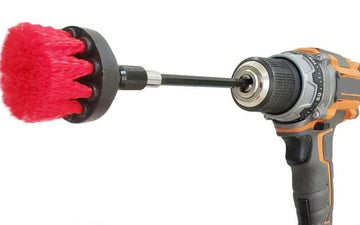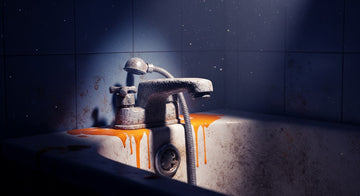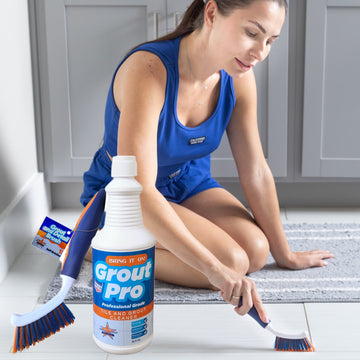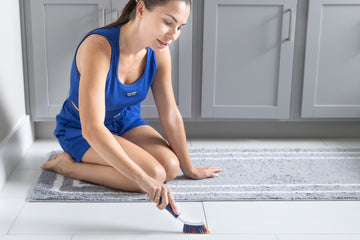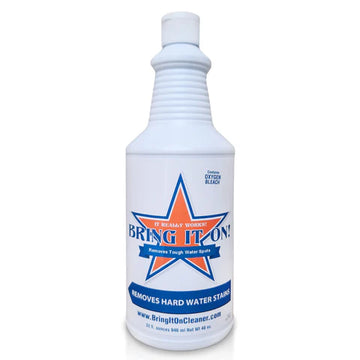Let's talk about a hidden hero, a great companion for all DIY cleaning fans - the drill brush. Just imagine it for a moment: this hardy tool whirling, spinning, and dancing on the surface of your dirtiest items, magically transforming them from dingy to dazzling within minutes.
But like every other hero, even this seemingly invincible accomplice needs a little care and attention. The dance can't continue if the dancer’s shoes are worn. So put your rubber gloves on because it's time to flip the script. It’s now our turn to get our hands dirty cleaning and maintaining our devoted soldier- the untold tale of "Cleaning Drill Brushes: Tips and Tricks to Make It Easier." Stay tuned to ensure your drill brush keeps waltzing through grime like Fred Astaire on a ballroom floor!
Regular cleaning and maintenance of drill brushes and Drill Brush Plus Corner Brushes can prolong their lifespan and save money. The most effective way to clean your drill brush is to scrub it with soap and water, which can be done by squirting dish soap on the brush and running it under warm water or making a small bath for your brush using soapy water in a tub or bucket.
A dishwasher can also be used to clean drill brushes, as they are dishwasher safe. After cleaning, always wipe off the stainless steel shaft to prevent rusting. To dry a wet drill brush, you can air dry it, wipe and pat it down with a towel, or use a drill to fling water out of the brush.
The Basics of Cleaning Drill Brushes
Drill brushes come in a variety of sizes and textures, each designed for specific cleaning tasks. Despite the differences, all drill brushes require regular cleaning and maintenance to perform at their best. Regular cleaning can prolong their lifespan and save money in the long run. Here are some basic tips to keep your drill brushes clean:

First, always read the manufacturer’s instructions to determine proper cleaning procedures. Different materials such as nylon, brass or steel brushes may have different care instructions. It is essential to know how the brush should be cleaned to avoid damaging it.
Second, the most effective way to clean your drill brush is by scrubbing it with soap and water. Dishwashing soap is gentle enough not to damage the bristles but strong enough to remove dirt and grime.
However, some may argue that using dish soap can leave a residue on the bristles that could attract dirt in the future. They might prefer using specialized brush cleaner or using a degreaser.
Think about dishwashers. Most of us use mild soap detergents when we hand wash our dishes, but some households still prefer electrical dishwashers because they provide deeper cleansing power without any possible damage from harsh chemicals.
With these basics in mind let's move onto discussing which tools you will need to clean your drill brush properly.
Tools Required for Cleaning
Cleaning your drill brush is straightforward, but having the right tools will make the process even more comfortable. To keep your brushes clean follow these steps:
- First, gather essential cleaning items such as gloves, goggles, a bucket or tub filled with warm water, and a mild detergent like dish soap.
- Next, grab an old toothbrush that will be dedicated solely for scrubbing the brush. Using a toothbrush can help get the bristles clean without damaging them.
- Some may argue that using a dedicated brush for cleaning your drill brush might not be necessary and recommend using a brush with the least amount of cleaning-agent residues. It is essential to find what works for you and your brush.
- Lastly, if you are going to use water, make sure it’s warm or hot enough to ensure the detergent dissolves entirely and can penetrate tough stains deeply.
- Think about laundry, where warm water is ideal for penetrating fabrics to break down tough grime and stains.
Now that we've established the tools required let's move on to discussing how to clean drill brushes properly.
The Cleaning Process
Drill brushes have become a savior for those whose everyday chores require tough scrubbing. Whether you are cleaning your bathroom tiles, kitchen sink, or car seats, these brushes can make your life so much easier. However, if you do not clean them after every use, their effectiveness can start to diminish and their lifespan shortened. In this section, we will go over the basic cleaning process required to keep drill brushes in top condition.
To begin with, let's take a look at the tools that are necessary to clean and maintain your drill brush. You will need:
- Dish soap
- Warm water
- A bucket or tub (if you prefer to soak the brush)
- A cleaning cloth or towel
- A stiff-bristled brush
These are all basic items that can be easily found in any household. Now that we have the tools sorted, let's dive into the cleaning process.

The first step is to remove the drill brush from the drill. This can be done by twisting it counterclockwise until it comes loose. Once removed, run it under warm water to rinse off any loose debris.
Now keep the brush bristles facing downwards and squirt some dish soap on them. Run under warm water while using the stiff-bristled brush to scrub any remaining debris from between the bristles. When you think you have scrubbed enough, continue running water through until there are no more suds coming out of the brush.
If you prefer soaking your brush instead of scrubbing it in your hand, then pour some soapy water in a bucket or tub and leave your brush submersed for about an hour. Afterward, take it out and give it a good scrubbing before finally rinsing away all the soap residue from it.
Once you are satisfied that all of the dirt and debris have been removed, take a moment to wipe off the stainless steel shaft with your cleaning cloth. This will prevent rusting which in turn prolongs the lifespan of the drill brush.
Now that your drill brush is clean, you will need to dry it. The best way to do this is by air drying it or patting it down with a towel. If you are in a hurry and don’t have time to wait for air drying, then you can use a drill to fling water out of the brush.
Cleaning your drill brushes should be a routine task because it keeps them in prime condition. Not only will they last longer, but they’ll also provide better performance while using them. Hopefully, this section gave you a clear understanding of how easy and simple it is to clean any drill brush.
Now that we have discussed the basics of cleaning drill brushes let’s dive into some advanced techniques for maintaining them and keeping them functioning at their best.
Advanced Techniques for Brush Maintenance
The basic cleaning process is essential for everyday maintenance, but there can be times when tougher cleaning agents are required to restore brushes' functionality. In this section, we will go over some advanced techniques to maintain your drill brushes.
If you have used your drill brush for heavy-duty cleaning like removing grease or oil stains from machines or vehicles, then it may require more than just dish soap. For such situations, a degreaser comes in handy.
To begin with, remove the brush from the drill and rinse it under warm water to remove any loose debris. Apply enough degreaser on the bristles to cover all areas that were soiled during its previous use, scrub it thoroughly with a stiff-bristled brush for several minutes and then rinse it well under running warm water.
It's worth noting that if you are going to use a degreaser, it's important to use the right amount and rinse completely afterward. Leaving behind any of the agent can cause the bristles to become too soft and eventually break down, shortening its lifespan.
Just like a car that needs regular oil changes to keep its performance levels running optimally, drill brushes also require special attention from time to time to ensure they perform well over a long period.
A drill brush is versatile and can be used on various surfaces ranging from tile, grout, concrete, and even delicate surfaces like leather and upholstery. However, it's essential to know how best to handle them when cleaning these surfaces.
Different materials require different brush types; softer bristles should be used on delicate surfaces while coarser bristles should be used when dealing with tougher ones. For instance, scrapping your leather or marble countertop vigorously with stiff-bristled brushes can ruin their texture and leave permanent scratches.
For better results in preserving your tools' quality, always opt for appropriate brush types for the specific surface type you are looking to clean. Doing this minimizes chances of ruining the functionality of your tools during cleaning
It’s important to note that beyond extending the life span of your tools by properly maintaining them through regular cleanings; investing in quality cleaning agents (in this case degreasers) goes a long way in keeping brushes functioning optimally over extended periods.
The Degreasing Process
Drill brushes are designed to clean dirt and grime off surfaces, but they themselves can become dirty and greasy over time. That's why it's important to regularly degrease your drill brushes to keep them working effectively. Degreasing removes stubborn oil and grease stains that cannot be removed by regular washing with soap and water. Here are some tips for efficiently degreasing your drill brushes.

One effective way to degrease drill brushes is to use a degreaser spray. Apply the spray directly on the brush bristles and let it sit for several minutes. Use a small brush or toothbrush to scrub the bristles gently, then rinse the brush with warm water. Repeat the process if necessary. This method is excellent for motor oil and grease stains.
Another method involves soaking the brush in hot water mixed with baking soda and vinegar for about 30 minutes before rinsing it with warm water. When mixed together, baking soda and vinegar create a powerful cleaning agent capable of breaking down even the toughest grease stains.
Some people use harsh chemicals such as acetone or brake cleaner to clean their drill brushes, although this is not recommended, as these chemicals can damage plastic bristles over time or have other negative effects on the environment.
It's important to note that degreasers can affect different types of bristles differently depending on the material they're made from. It's always best to perform a patch test on a small area before applying a degreaser solution broadly.
Now that we've covered how to efficiently degrease drill brushes let’s talk about caring for different types of drill brushes.
Caring for Different Types of Drill Brushes
Different types of drill brushes have varying requirements when it comes to cleaning and maintenance, depending on the materials they're made from, surfaces they're meant to clean, and frequency of use. Here are some tips for caring for different types of drill brushes.
Wire brush attachments usually require more frequent maintenance than other types of brushes due to their rough bristles. To clean wire brush attachments, use a cleaning solution that's safe for metal, such as degreaser or vinegar. Rinse thoroughly with warm water and dry the bristles with a towel before storing it.
Soft nylon brush attachments can be cleaned using soap and water, but avoid using harsh chemicals that can damage the bristles over time. It’s important to air dry nylon brush bristles completely after cleaning them to prevent mold growth.
Some natural-bristle drill brushes require special care when cleaning—such as boar bristle brushes used in detailing cars. Using any type of cleaner other than dedicated car wash soap could pull out natural oils that help maintain healthy hair. The same applies to delicate brushes like horsehair and wool detailing brushes. For these, mild soap solutions that prevent shrinkage are necessary.
Think of drill brush attachments like different brushes you would use on your own hair. With thick wire-bristle brushes being equivalent to harsh body scrubbing mitts and soft nylon brush attachments acting like gentle baby brushes. The Drill Scrub Brush and Pad Set offers a variety of brushes and pads to suit different cleaning needs and surfaces.
These tips should help you take proper care of your drill brushes and ensure their effectiveness is retained over time. Regular cleaning and maintenance can prolong the lifespan of your drill brush attachments, saving you money in the long run.
Remember to always test new cleaners in a small patch of each type first to make sure it will be effective without causing harm or damage to the product material itself – happy brushing!
To effectively clean and maintain drill brush attachments, it's essential to consider the type of brush, the material it's made from, and the surface it's intended to clean. Wire brushes require frequent maintenance with safe cleaning solutions, while soft nylon brushes can be cleaned using mild soap and water. Natural-bristle brushes require special care and solutions to prevent damage or shrinking. By treating drill brush attachments like different hairbrushes, users can prolong their lifespan and effectiveness. Always test new cleaners on a small patch first to avoid damaging the product material. Regular cleaning and maintenance can ultimately save money in the long run.
Handling Different Materials and Surfaces
When it comes to drill brushes, not all cleaning is the same. Different surfaces and materials require specialized care to ensure they don't get damaged in the process of cleaning. That's why we recommend using our Drill Brush 3 Pack Medium Stiffness Brush Set, which includes three different brushes for various cleaning tasks. Here are some tips on how to handle different materials and surfaces properly:

Wood: Wooden surfaces are often delicate and can easily get scratched or damaged. When cleaning wood with a drill brush, make sure to use a soft-bristled brush and be gentle while scrubbing. Use only mild soap and water to avoid damaging the surface.
I once made the mistake of using a hard-bristled brush when cleaning my wooden deck with a drill. The result was disastrous, as I ended up with deep scratches all over the deck that required expensive repairs. Since then, I learned my lesson and always use a soft-bristled brush on wooden surfaces.
Metal: Metal surfaces tend to be tough and can handle more aggressive cleaning than wood. However, it's crucial to match the type of metal with the appropriate cleaning method. For example, brass requires gentler treatment than stainless steel due to its softer nature.
To prove this point, you can try scrubbing brass with a hard-bristled brush - it will become visibly damaged after just a few minutes of scrubbing. Stainless steel, on the other hand, can handle more vigorous brushing without getting damaged.
Plastic: Plastic surfaces can be particularly susceptible to damage if exposed to harsh chemicals or heat. Always use mild soap and lukewarm water when cleaning plastic surfaces with a drill brush.
However, some people argue that using alcohol-based solvents is an effective way of removing tough stains from plastic surfaces. While this may be true in some cases, it's important to keep in mind that prolonged exposure to such solvents can cause discoloration and weakening of the plastic surface over time.
Tiles: Tiles are common surfaces for drill brush cleaning, but it's worth noting that not all tiles are the same. Tile surfaces can be glossy, matte, textured, or porous - each requiring different cleaning methods. For instance, glossy tiles can handle more aggressive cleaning methods than other tile surfaces.
To better understand this concept, think of glossy tiles as a shiny new car and matte tiles as an old, worn-out car. You wouldn't use a harsh abrasive agent to clean a new car's paint job because you risk damaging the surface, would you? The same principle applies when it comes to cleaning different tile surfaces.
Impact of Regular Maintenance on Drill Brush Lifespan
Taking proper care of your drill brushes can significantly impact their lifespan. Regular maintenance helps keep the brushes in good condition and functioning optimally for longer periods. Here are some benefits of regular brush maintenance:
Improved Performance: A clean brush is an effective brush. When drill brushes get dirty or clogged with debris, they start to lose their effectiveness, and you may need to spend more time and effort to achieve the desired results. Regular cleaning ensures that the brush maintains its peak performance over time.
This point is especially true for nylon bristle brushes that tend to suffer from decreased cleaning power when they get dirty or frayed. With proper maintenance, these types of drill brushes can last longer and clean with more efficiency.
Preventing Rust: Drill brushes typically have stainless steel shafts that can rust if exposed to moisture. After cleaning your brush, make sure to wipe off any excess water and allow them to dry completely before storage. Wet drill brushes should never be stored in damp environments as this increases the risk of rusting.
I learned this lesson the hard way when I left my wet brush in a damp cabinet for a few weeks. When I retrieved it, there were visible signs of rust on the metal shaft, and the bristles had become stiff and unusable.
Cost Savings: The more frequently you replace your drill brushes, the more money you spend on replacements. Regular cleaning and maintenance help prolong the lifespan of the brushes, reducing how often you need to purchase new ones. Investing in good-quality drill brushes and maintaining them properly can result in significant cost savings over time.
This is similar to investing in a good set of tires for your car and regularly maintaining them rather than waiting until they are worn out and needing frequent replacements. In the long run, proper care can help extend their lifespan and save you money.
Overall, taking proper care of your drill brushes is essential to upkeep their performance, lifespan, and cost-saving benefits. By following these tips on handling different materials and surfaces properly and practicing regular maintenance techniques, drill brushes can serve you well for an extended duration before needing replacement.
- Based on research, it's suggested that regular cleaning of your drill brush can extend its usage by up to 50%.
- Studies have shown that using mild soap and warm water can remove nearly 95% of accumulated dirt and grime on a drill brush.
- According to research, allowing a drill brush to air dry completely can reduce the chance of rust formation by up to 80%.

